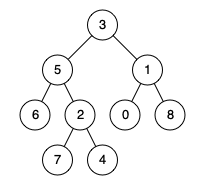二叉树的最近公共祖先
题目:
给定一个二叉树, 找到该树中两个指定节点的最近公共祖先。
百度百科中最近公共祖先的定义为:“对于有根树 T 的两个结点 p、q,最近公共祖先表示为一个结点 x,满足 x 是 p、q 的祖先且 x 的深度尽可能大(一个节点也可以是它自己的祖先)。”
例如,给定如下二叉树: root = [3,5,1,6,2,0,8,null,null,7,4]
https://assets.leetcode-cn.com/aliyun-lc-upload/uploads/2018/12/15/binarytree.png
示例 1:
输入: root = [3,5,1,6,2,0,8,null,null,7,4], p = 5, q = 1
输出: 3
解释: 节点 5 和节点 1 的最近公共祖先是节点 3。
示例 2:
输入: root = [3,5,1,6,2,0,8,null,null,7,4], p = 5, q = 4
输出: 5
解释: 节点 5 和节点 4 的最近公共祖先是节点 5。因为根据定义最近公共祖先节点可以为节点本身。
解题思路:用递归解决,递归函数的节点只有几种情况
- 节点为null,直接返回null
- 节点是p或者q,那就返回该节点
- 都不是,就需要判断该节点的左子树或者右子树是否含有p或q
/**
* Definition for a binary tree node.
* public class TreeNode {
* int val;
* TreeNode left;
* TreeNode right;
* TreeNode(int x) { val = x; }
* }
*/
class Solution {
public TreeNode lowestCommonAncestor(TreeNode root, TreeNode p, TreeNode q) {
return find(root, p, q);
}
//如果找到了p或q节点则返回该节点
private TreeNode find(TreeNode node, TreeNode p, TreeNode q) {
if(node == null)
return null;
if(node == p || node == q)
return node;
TreeNode left = find(node.left, p, q);
TreeNode right = find(node.right, p, q);
//左右子树都没有p,q
if(left == null && right == null)
return null;
//右子树有p,q
if(left == null && right != null)
return right;
//左子树有p,q
if(left != null && right == null)
return left;
// p,q都在该节点的左右子树那该节点就是最小公共祖先
return node;
}
}





 浙公网安备 33010602011771号
浙公网安备 33010602011771号